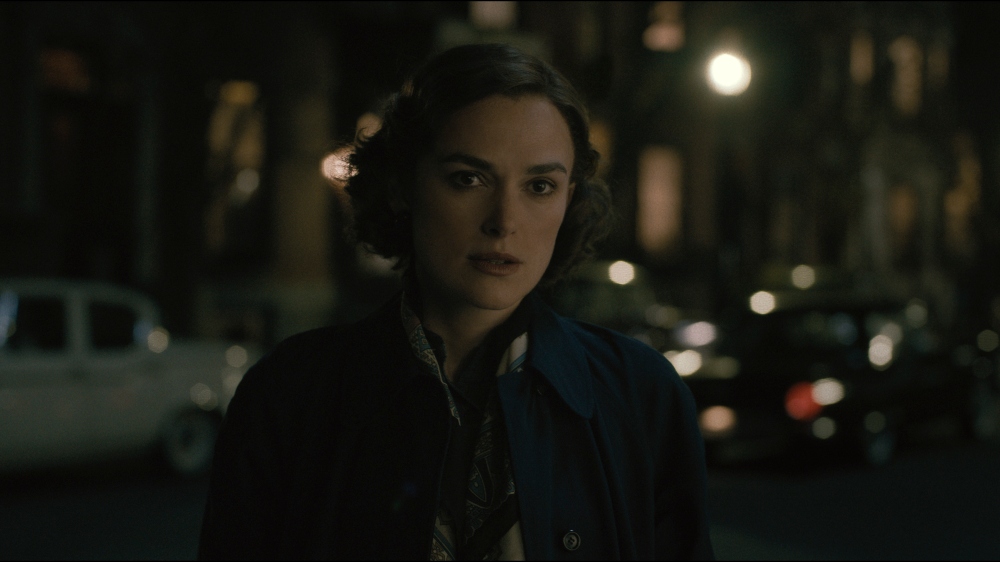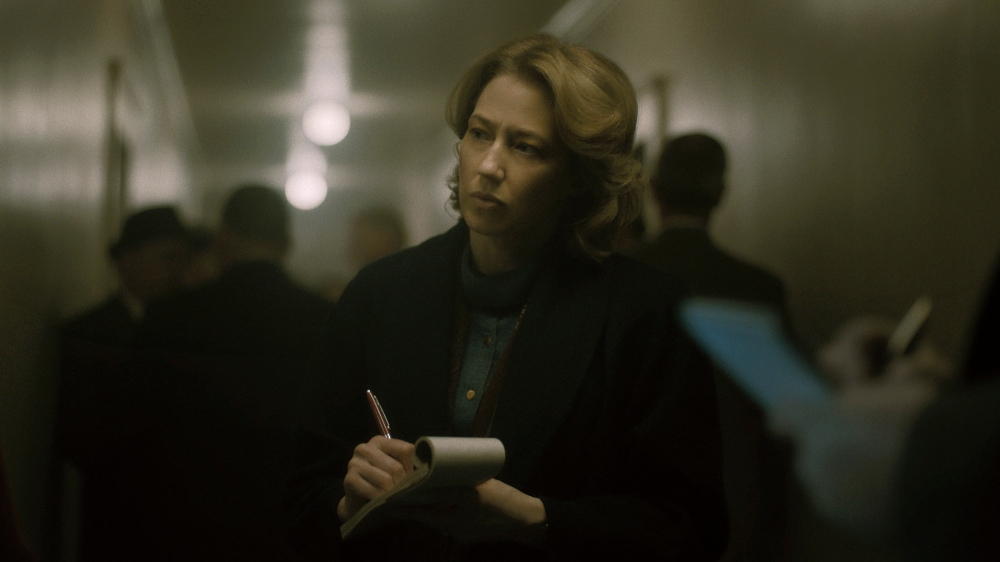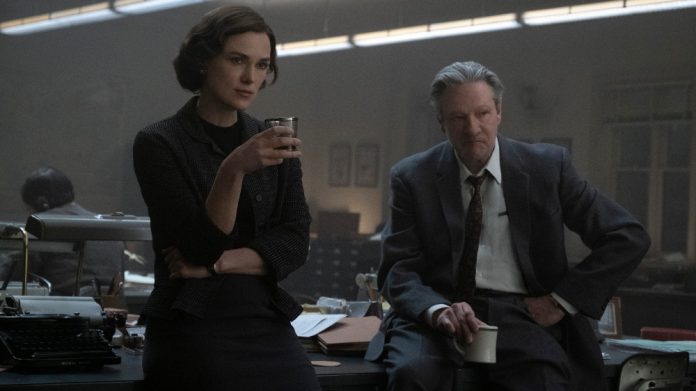It was almost six decades ago that the aptly-named Boston Strangler went on his killing rampage, brutally murdering 13 women throughout Boston and its neighboring cities over a two-year span from 1962-1964. Some 50 years later, all but one murder remains unsolved thanks to DNA evidence implicating Albert DeSalvo, who was found guilty of the rape and murder of the last victim in January 1964.
When Boston Strangler writer, producer, and director Matt Ruskin (Crown Heights, The Infiltrator, The Hip Hop Project) was looking for a different way of revisiting the still-unsolved mystery for his new Hulu movie, the Boston-native zeroed in on the women behind the headlines who covered the story for the local newspaper, the Record American. Loretta McLaughlin (Keira Knightley) was the first person to connect the series of murders and break the story of a possible serial killer along with fellow reporter Jean Cole (Carrie Coon), and they did so at a time in the early 1960s when sexism still ran rampant — even in the newsroom.
Above the Line spoke with Matt Ruskin over Zoom from his office in Los Angeles, where he discussed taking a deep journalistic dive through archival writings dating back to the beginning of McLaughlin and Cole’s coverage. While researching the two women, he reveals how he met their surviving relatives and the discoveries he made along the way that resonated with him personally.
As a director, he talks about the challenges of shooting in and around Boston where the murders took place while minding both the time period and the violence, and perhaps most importantly, remaining respectful to the victims. Ruskin hopes that modern audiences will be intrigued by the reporters’ findings, but you’ll have to watch the movie to find out their working theory — no spoilers here!

Above the Line: Let’s start with the beginning. What inspired you to tell the story of the Boston Strangler case?
Matt Ruskin: I grew up in Boston, and I had heard about the Boston Strangler my whole life but I really didn’t know anything about the case. And then a few years ago, I was looking for something new to write about and I started reading about the Boston Strangler. I got my hands on everything I could find, and I discovered this incredibly layered murder mystery at the heart of the story. It was full of these really unexpected twists and turns, and I thought that it would make for a really compelling film. But, I just couldn’t get inspired about telling the sort of hard-boiled detective story, especially since there were so many questions around the investigation and the fact that nobody was ever charged with or convicted of any of the Boston Strangler murders.
ATL: Why did you want to tell it from the point of view of the female journalists who covered the story?
Ruskin: I discovered an interview with Loretta McLaughlin. It was a very brief interview, but I found out that she was one of the first reporters to initially connect the murders. She really broke the story of the Boston Strangler, and she gave the Boston Strangler his name during the course of her reporting. And I love journalism stories. I really respect and admire great journalism and good journalists. So I thought that’d be a really interesting way in. I tried to find out everything I could about Loretta and her reporting partner, Jean Cole, but there’s very little written about her.

ATL: Do they still have surviving relatives that you were able to reach out to?
Ruskin: They do, but there’s very little information about them available. I read Jean’s obituary, and it mentioned that she had two daughters. I actually ended up looking them up on Facebook, and one of them had a Facebook profile, and she had one photograph in her profile, and in that photo, she had her arm around an old friend of mine. I called up my friend, and I said, ‘How do you know this woman?’ And she said, ‘That’s my mom.’ And she explained that Jean Cole was her grandmother and this person whom she revered. So she introduced me to both [of] their families.
ATL: Wow! That’s a great story, Matt.
Ruskin: Yeah, it was really serendipitous. So I was able to talk to both Loretta and Jean’s kids. It really just opened things up for me. I felt like the more I learned about these women, the more I grew to admire them as people and as reporters. It felt like a really compelling way to revisit the Boston Strangler case through the perspectives of these two journalists.
ATL: In casting the roles of Loretta McLaughlin and Jean Cole, did you recognize the chemistry between Keira Knightley and Carrie Coon right off the bat?
Ruskin: Their chemistry was definitely a discovery. We went to Keira first, as you would for the lead actor of a film. I have so much admiration for both of them individually, but I had no idea that they would have this incredible chemistry together. I hoped that they would, but it exceeded all hopes and expectations. They just personally and professionally had a lot in common and immediately hit it off. They had an incredible chemistry that really came through, and for me, that was one of the highlights of the film.

ATL: Did you shoot this in an actual newsroom?
Ruskin: We actually built the newsroom. That’s a set that we built. We just were not able to find a space that was big enough with the old bones that we needed where we could work as a crew. And during COVID, you need so much more additional holding space to keep everybody safe and adequately distanced. It was just not feasible to find a practical location. So we actually built this newsroom based on images that we had of the old Record American newsroom.
ATL: When researching the coverage from the Record American, what did you discover?
Ruskin: One of the amazing things is that much of their archives have been digitized, so I was able to go back and actually look at all of the reporting that Loretta and Jean did on the Boston Strangler, as well as some of the stories before that. There’s a great photo spread of Jean Cole dressed as a nurse reporting on nursing homes, which makes an appearance [at] the beginning of the film. It was amazing to be able to read their reporting to get a better sense of the case, but also to understand and hear their voice as journalists. Some of their writing actually made the film, which was great.
ATL: From a director’s point of view, when filming the strangling scenes, we don’t actually see the murders but we hear them. Were you influenced by Brian De Palma by any chance?
Ruskin: I love Brian De Palma. I wasn’t really thinking about his films when we were making this movie [but] I know what you mean. But it was really important to be respectful to the victims while also trying to make a really gripping, horrifying thriller about this. I didn’t want to create a gratuitous depiction of violence in any way, but I also wanted people to experience the horror of it. One of the things I discovered about depicting some of this violence off-screen was that hearing it just in the next room was almost more horrifying than if we tried to point our cameras at it.

ATL: Talk about shooting in this time period. What were the challenges of getting all the props and locations right?
Ruskin: We were really lucky to be able to shoot in Boston, in and around where a lot of this really took place, but the city has changed so much. There are a handful of old neighborhoods with beautiful old brownstones that haven’t changed in a hundred years or more. So when we brought out all of these cars from the 1950s and early 1960s, it was amazing to see those neighborhoods transform.
It was definitely a labor of love with an incredible production designer (John P. Goldsmith) and an incredible costume designer (Arjun Bhasin), really finding not just costumes, clothing, wallpaper, and appliances from that period, but appliances that were appropriate for these people and clothes that these women, who were going to work every day on a budget, would’ve worn.
I live for those details, and it was incredible to be able to be so focused on the little elements that made it so specific to that time and place. We definitely looked at photos of them and tried to honor the characteristics of who they were and their personalities. But there are some liberties you have to take, like making sure that Carrie and Keira feel comfortable and grounded in the wardrobes that they are wearing.
ATL: Was there ever a time while you were shooting where you had to stop and ask, “whose cell phone is that?”
Ruskin: [laughs] Yeah. I think accidentally somebody’s laptop was in the corner of a frame in the newsroom once, and we were like, ‘That doesn’t belong.’ We had a debate over it. The prop master gave one of the actors a BIC pen, and everyone was like, ‘That’s a brand new BIC pen.’ And we looked it up, and they haven’t changed in 60 years! It was great to have the opportunity to go back and revisit all of the different things from that period.
ATL: This story takes place in Boston, yet you don’t really harp on the actors using a Boston accent. Why is that?
Ruskin: I grew up in Boston. I don’t have a Boston accent. My folks met at school (in Boston). There wasn’t an accent in the home; it was everywhere else, and I could have it if I wanted it. I know a lot of people who don’t have Boston accents. Being a cinephile and having seen most of the movies filmed in Boston, I have a hard time with [the] accents, whether they’re good or bad; they seem to just be a distraction. And so I really urged everyone to back away from that because I didn’t want people talking about the accents. I wanted people to talk about the characters in the story. I really just hope that people have the same experience that I did when I started reading about the case. I found it to be this incredibly gripping murder mystery with these really compelling and inspiring characters at the heart of the story of reporting on it.
ATL: There is a scene where you show one of the newspapers and the headline reads “Girl Reporters.” I hope we’ve come a long way since then. Why is this story still so revelent to today, even though it happened almost 60 years ago?
Ruskin: Yeah, that’s a real headline. You know, there was a famous movie made in the late 1960s with Tony Curtis about the Boston Strangler. What I discovered in my reading is that there are many more layers to the mystery of the story that haven’t been told. I think that the journalism piece of it — the need for good journalism [and] for reporters and institutions that are committed to getting at the truth — is as relevant today as it was back then. It’s as relevant as ever. So that thread felt very current to me. Just on a personal level, in terms of Loretta’s story and Jean’s as well, they were willing to challenge the norms of the era to do the work that was so important to them. I found that to be very inspiring and, in many ways, timeless.
Boston Strangler is now streaming on Hulu courtesy of 20th Century Studios.



